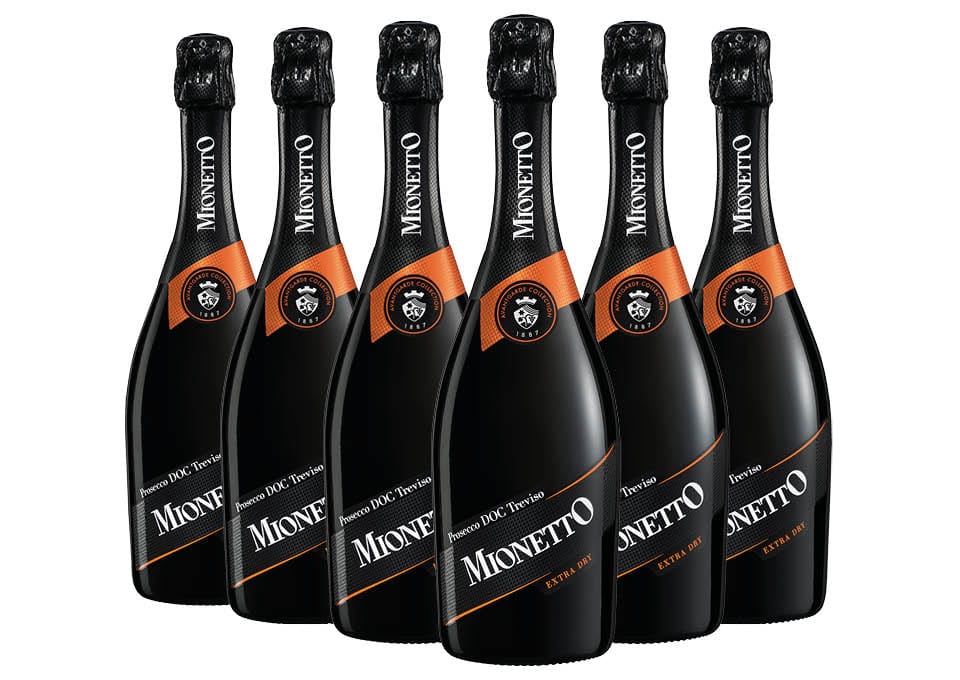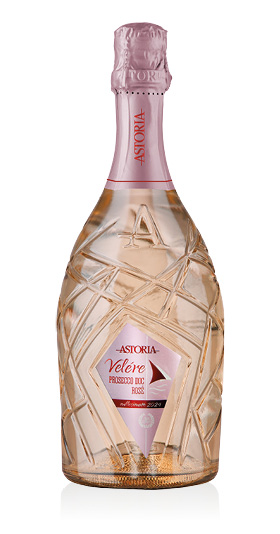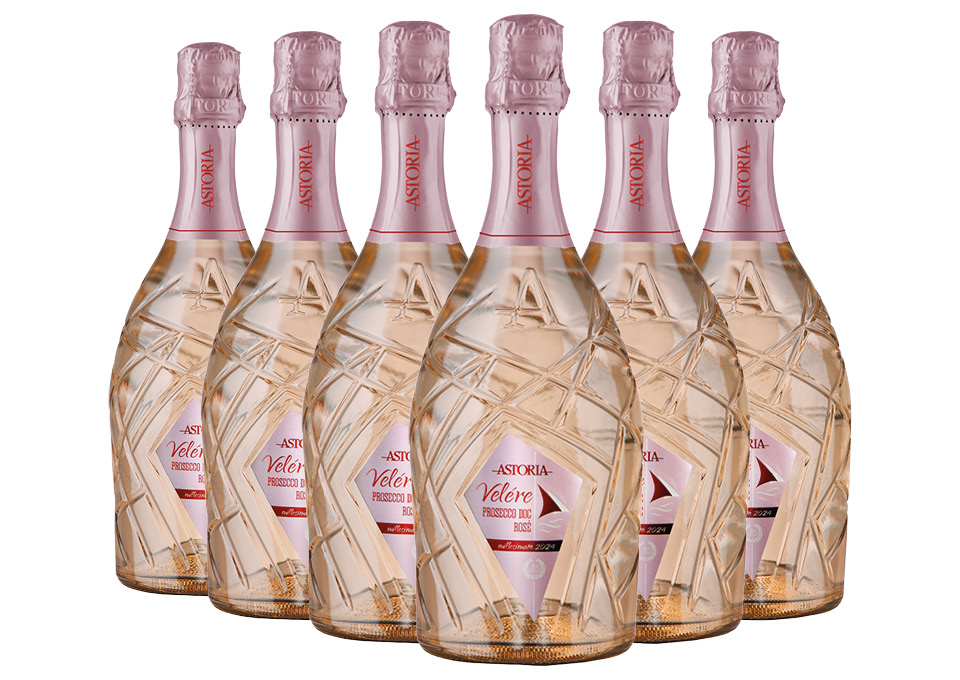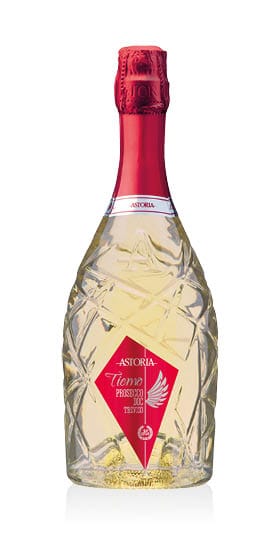Prosecco, Veneto
Prosecco is without doubt the most popular Italian sparkling wine in the world. It is perfect as an aperitif or with a wide variety of dishes, like shellfish, light meats and desserts.
In Italy the region which produces it, is Veneto. It is produced in the hilly area between the towns of Conegliano and Valdobbiadene, less than an hour from Venice.
Wine-making here has ancient origins, the word Prosecco was first mentioned in 1772. A central role in the area is played by the Conegliano Oenological School. This is where the Conegliano Valdobbiadene Method, a version of the Martinotti Method, was created. Unlike the Metodo Classico, the Martinotti Method requires the second fermentation to take place in an autoclave.
This sparkling wine is produced from Glera grapes in italy, which make up at least 85% of the blend. In the area, the soil is rocky, the climate mild and the rainfall just right.
It is a variety with golden-yellow berries and typical aromas are fruity, such as green apple and grapefruit, and floral. The other grape varieties allowed are: Perera, Glera Lunga, Verdisio, Bianchetta Trevigiana, Chardonnay, Pinot Bianco and Pinot Grigio.
It is an elegant and informal bubbly. Depending on the residual sugar content, it can be of different types: Extra Brut, Brut, Extra Dry, Dry.
It can be labelled as millesimato. This means that all the grapes used to produce it were harvested in the same year. The term millesimato means that the grape used are not cuvées from different vintages and will therefore always have a reference vintage.
Speaking of Prosecco, we cannot fail to mention Prosecco Superiore di Conegliano Valdobbiadene DOCG. In fact, in 2009, the sparkling wine produced only in the municipalities of Conegliano and Valdobbiadene changed from DOC to DOCG. In addition to this DOCG, the two other high quality Cru wines where also created in the sub-areas of Rive and Cartizze.
How much should a bottle of Prosecco cost?
It is reliable, affordable and high quality sparkling wine.
The price of a bottle depends on a variety of factors, such as the area where it is produced.
The price varies widely. For example, you can choose a Mionetto of the Freixenet prosecco group. Or choose a Prosecco Extra Dry Rosé DOC Velére 2021 from the famous Italian brand Astoria at a lower price, but still excellent.
It has not got an excessive price thanks to its production method, the Charmat or tank method and so, it can be more affordable than Champagne, but still be elegant and perfect for every occasion.
Is Prosecco different than Champagne?
There are three main differences between the two sparkling wines:
The first main difference is the origin. The Italy Prosecco region is Veneto and it can only be produced there. Champagne can only be produced in the Champagne region, in France.
The second important difference is the grape variety used. Prosecco is made with the native grape variety Glera, that is exclusive to Italy. On the other hand Champagne can be made with Chardonnay, Pinot Noir and Pinot Meunier grapes.
Last but not least, the third difference is found in the production method. Prosecco is made with the tank method a.k.a. Charmat Method, and Champagne with the Traditional method, aka Méthode Champenoise or Metodo Classico. Prosecco undergoes the second fermentation in a pressure-resistant tank, instead the Champagne second fermentation is done in bottle. The ageing process goes from 9 months to 5 years in bottle, therefore taking more time for production.
Prosecco flavours: Glera grapes give fruit and flower aromas, aromas of tropical fruits, such as passion fruit, banana cream, hazelnut, vanilla, and honeycomb. Because Proseccco ages in large tanks with less pressure, has lighter, frothy bubbles that don’t last as long.
Champagne flavours: almond-like flavors, notes of orange-zest, white cherry, toast, brioche, or biscuit. Due to the high pressure during production has fine, persistent bubbles.
Its flavours are distinctive as it is delicious with asiago cheese.
Is Prosecco sparkling wine?
Yes, it is the best Italian sparkling wine!
It has 4 sweetness levels: Brut, Extra Brut, Extra Dry and Dry.
There are different quality levels and the superior qualities are Conegliano Valdobbiadene Prosecco Superiore DOCG, Conegliano Valdobbiadene Prosecco Superiore Rive DOCG, Valdobbiadene Superiore Cartizze DOCG, Asolo Prosecco DOCG.
Here a list of prosecco cocktail recipes:
- Aperol Spritz: pour the Prosecco (6 cl), Aperol (4 cl) and soda (2 cl) into a wine glass with ice. Garnish with orange slice.
- Hugo: fill a wine glass with ice and with some torn mint leaves, 30ml of elderflower and soda. Top up with Prosecco.
- Bellini: pour some Prosecco in your glass and top off with peach juice or nectar!
- Negroni Sbagliato: fill an old-fashioned glass with ice. Add vermouth and Campari and stir. Top with Prosecco and stir again. Garnish with an orange slice.
- Pink Gin Fizz: fill a wine glass with ice and mix in Pink Gin and lemon juice. Top up with Prosecco and garnish with a few fresh strawberries
Why buy Prosecco online
There are different types of Prosecco DOC, which is why it can be tedious to know how to choose the most suitable one. Taste and residual sugar are the main differences.
We advise you to choose one online depending on the occasion. You can pair it with an appetiser, enjoy it as an aperitif or with a dish.
Buying it online will allow you to receive your favourite bottles in the comfort of your own home, choosing according to your personal taste.
It is an elegant and versatile wine, suitable for all occasions. You can choose the more classic Prosecco Villa Sandi: fruity, smooth and suitable for the most refined aperitifs. Prosecco Sant'Orsola: persistent and with a fine perlage.
And you cannot miss the famous Prosecco DOC Treviso Brut Mionetto, with its hint of golden apple and honey. Whatever your choice is, with Vino.com you cannot go wrong.
 Veneto is a land of ancient winemaking traditions, which today boasts the primacy in Italy for the production of DOC wines. The wine production of the region is qualified not only through the widest and most varied panorama of vineyards and wines, from whites to reds, from sparkling wines to passito, but also thanks to a strong vocation for quality, with as many as 14 DOCG wines, 28 DOC wines and 10 IGT wines.
Veneto is a land of ancient winemaking traditions, which today boasts the primacy in Italy for the production of DOC wines. The wine production of the region is qualified not only through the widest and most varied panorama of vineyards and wines, from whites to reds, from sparkling wines to passito, but also thanks to a strong vocation for quality, with as many as 14 DOCG wines, 28 DOC wines and 10 IGT wines.
Much of the Veneto, due to its climatic and morphological characteristics, is an area where excellent grapes are grown; viticulture is practiced both in the flat area, very rich in streams, and on the hills, which have a mild climate and fertile soils. With its 78,200 hectares of vineyards it is certainly one of the most interesting regions, especially for the variety of wines produced there, from the great reds of Valpolicella such as Amarone and Ripasso, to the fragrant and intense whites such as Soave and Lugana (appellation that it shares with the Lombardia) to Prosecco in its various variations, from Asolo DOCG to Cartizze.
Venetian red wine
Venetian red wine is known all over the world thanks to Amarone della Valpolicella. This red wine obtained from grapes subjected to drying ranks among the great Italian reds, and due to its characteristics of longevity and structure it is often one of the most coveted wines by collectors. In Valpolicella, however, there is also Valpolicella ripasso (obtained by resting on the lees of Amarone), and classic and superior Valpolicella. Not far away, we find Bardolino, more fruity and easy to drink, especially loved across the border. In Veneto there are also non-native grapes, such as on the Colli Berici, where Cabernet Sauvignon and Merlot are at home, alongside the curious local grape tocai rosso, similar to cannonau or grenache. Finally, interesting results are obtained from the carmenere grape and above all from the Raboso, which gives life to an excellent red wine and a noteworthy passito.
Veneto white wine
Veneto white wine has been successful thanks to the Lugana appellation (in common with Lombardy), an excellent white wine with complex aromas, which is also interesting for aging. The Soave and Gambellara appellation was also of great importance, in which white wines have made famous producers such as Pieropan. Among the white grapes of interest there are undoubtedly the Vespaiola, with which the Torcolato di Breganze passito wine is produced, but also the yellow Moscato, which in the Euganean Hills originates the Moscato Fiori d'Arancio DOCG, a sweet sparkling wine with greedy aromas. However, white wine in Veneto means above all glera, with a growing production of Prosecco, which recently saw the release of the new Prosecco rosé, born from glera and pinot noir.
What is the best Venetian red wine?
Amarone della Valpolicella is undoubtedly the best Venetian red wine, and ranks among the best Italian wines thanks to its longevity, which allows it to age in the cellar for up to 20 or 30 years like Barolo and Brunello.
What is the best match for Veneto white wine?
Veneto white wine is rich in aromas and normally does not have much acidity, which is why it is suitable for pairing with river fish but also with egg-based dishes or enriched with sauces with aromatic herbs and bechamel. Try for example to combine Soave with pasta alla carbonara or Lugana with trout alla mugnaia, it will be a success!
Which are the most famous wine producers in Veneto?
The most famous wine producers of Veneto are undoubtedly those of Valpolicella, such as Quintarelli, Masi, Bertani, but also Tommasi, Dal Forno and Allegrini. However, there are also prominent names in the Soave appellation, such as Pieropan.


















